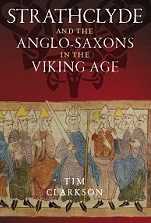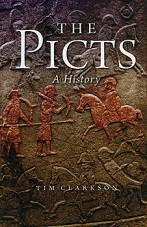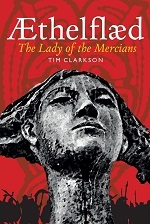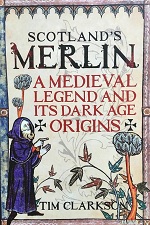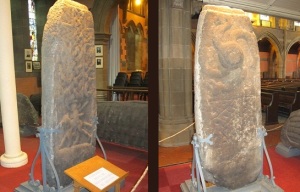
The Sun Stone at Govan (click to enlarge)
This is the most striking of the surviving cross-slabs at Govan. The main feature on the front is a cross with interlace patterns on the arms and shaft. Under each cross-arm a twisting serpent terminates in a head. Below the cross a square panel contains a human figure riding a strange, bear-like beast. Despite its odd appearance this animal might be a horse depicted in caricature, perhaps even one particular horse whose characteristics the sculptor wished to convey in the manner of a modern cartoon. Alternatively, the caricatured mount may have been intended as a comment on the rider himself. He is carrying a spear and wearing a sword: he is evidently a warrior. A curling adornment on the back of his head is usually interpreted as a pigtail.
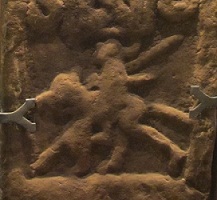
The rider on his strange beast
The reverse of the slab is dominated by a vivid design in the upper portion: four snakes protruding from a central boss. This is a Christian motif symbolising redemption and resurrection through the image of a creature that is ‘reborn’ each time it sheds its old skin. It is found elsewhere in Scotland in both Gaelic and Pictish contexts, respectively on crosses on Iona and Islay, and on a cross-slab at Nigg in Easter Ross. The same motif also appears on crosses in Ireland. At all these places the finely carved ‘snake-and-boss’ contrasts sharply with the crude version at Govan. What we see on the Sun Stone is a poor imitation of the design, an attempt by the craftsmen of Strathclyde to replicate the sophisticated artistry of the Gaelic world.[1] The same can be said of the Netherton Cross at Hamilton and the Dumb Proctor cross-shaft at Lochwinnoch, both of which contain crudely carved snake-and-boss ornament. All three were produced by craftsmen of the ‘Govan School’ stonecarving tradition.

The snake-and-boss symbol on the Sun Stone
Below the snake-and-boss on the Sun Stone is a square panel of interlace described by one modern observer as ‘botched’.[2] The irregularity of the pattern has led another expert to remark that ‘the Govan sculptor has failed to achieve symmetry, or deliberately scorned it’.[3] A glance at the panel reveals its main flaw: on three sides the interlace makes two triangles as it threads back on itself, but on the right-hand side an extra triangle completely disrupts the weave.
The Sun Stone was probably a memorial to a high-ranking Strathclyde aristocrat and may have marked his grave in the burial-ground of the ancient church at Govan. The absence of an inscription means that we do not know his name but he is perhaps the rider depicted on the front face below the cross.
* * * * * * *
Notes
[1] Ritchie (1999), 14, where the Sun Stone is seen as an instance of ‘the Govan patrons asking their sculptors to copy an image for which their talents were perhaps unsuited.’
[2] Macquarrie (2006), 5.
[3] Fisher (1994), 53.
* * * * * * *
References
Fisher, Ian (1994) ‘The Govan cross-shafts and early cross-slabs’, pp.47-53 in Anna Ritchie (ed.) Govan and its Early Medieval Sculpture (Stroud: Alan Sutton)
Macquarrie, Alan (2006) Crosses and Upright Monuments in Strathclyde: Typology, Dating and Purpose Fourth Annual Govan Lecture (Govan: Society of Friends of Govan Old)
Ritchie, Anna (1999) Govan and its Carved Stones (Balgavies/Brechin: Pinkfoot Press)
[All photographs in this blogpost are copyright © B Keeling]
* * * * * * *
Data summary
ECMS* Govan No.4 ‘The Sun Stone’
Current location: Govan Old Parish Church
Original location: (?) kirkyard of Govan Old
Dimensions: 1.85m x 0.55m x 0.18m
Material: sandstone
Date: 10th-11th century
* ECMS = J Anderson & JR Allen, The Early Christian Monuments of Scotland (Edinburgh, 1903)
Read Full Post »




